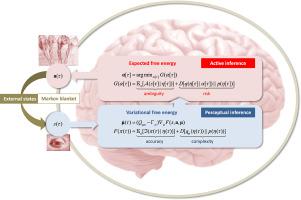Physics Reports ( IF 30.0 ) Pub Date : 2023-07-28 , DOI: 10.1016/j.physrep.2023.07.001 Karl Friston , Lancelot Da Costa , Noor Sajid , Conor Heins , Kai Ueltzhöffer , Grigorios A. Pavliotis , Thomas Parr

|
This paper provides a concise description of the free energy principle, starting from a formulation of random dynamical systems in terms of a Langevin equation and ending with a Bayesian mechanics that can be read as a physics of sentience. It rehearses the key steps using standard results from statistical physics. These steps entail (i) establishing a particular partition of states based upon conditional independencies that inherit from sparsely coupled dynamics, (ii) unpacking the implications of this partition in terms of Bayesian inference and (iii) describing the paths of particular states with a variational principle of least action. Teleologically, the free energy principle offers a normative account of self-organisation in terms of optimal Bayesian design and decision-making, in the sense of maximising marginal likelihood or Bayesian model evidence. In summary, starting from a description of the world in terms of random dynamical systems, we end up with a description of self-organisation as sentient behaviour that can be interpreted as self-evidencing; namely, self-assembly, autopoiesis or active inference.
中文翻译:

自由能原理变得更简单但又不太简单
本文提供了对自由能原理的简明描述,从用朗之万方程表述随机动力系统开始,到可以理解为感知物理学的贝叶斯力学结束。它使用统计物理学的标准结果来演练关键步骤。这些步骤需要(i)基于继承自稀疏耦合动态的条件独立性建立特定的状态划分,(ii)用贝叶斯推理解开该划分的含义,以及(iii)用变分法描述特定状态的路径最少行动原则。从目的论上讲,自由能原理在最佳贝叶斯设计和决策方面提供了自组织的规范性解释,在最大化边际可能性或贝叶斯模型证据的意义上。总之,从随机动力系统对世界的描述开始,我们最终将自组织描述为有感知的行为,可以解释为不证自明的;即自组装、自创生或主动推理。



























 京公网安备 11010802027423号
京公网安备 11010802027423号